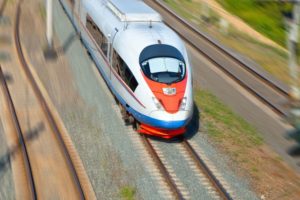Quick Navigation
It’s a situation that everyone dreads – being stuck on train tracks with an oncoming train. Many believe that getting stuck on the train tracks is a scarce situation.

But stats prove to be otherwise. Thousands of cases are reported of cars getting stuck on a train track every year.
But why do cars get stuck on train tracks? We’ll explore the causes of this phenomenon below.
Stats of Cars Getting Stuck on Train Tracks
According to Railroad Safety Commission, there were over 28,000 reported cases of such incidents. It is more than double the reported incidents in 2019, which is 12,116.
In addition to representing an increase of 133%, it also marked a 25-year high for railway crossing incidents.
Moreover, most of these trains were passenger cars – 75% – with an additional 5% being vehicles designed explicitly for railroad transportation.
It underscores the importance of motorists paying attention when approaching train tracks and exercising caution at all times.
Causes of Cars Getting Stuck on Train Tracks
The most common cause for cars getting stuck on train tracks is driver error or negligence. It could include not paying attention to railway signs and warnings.
Also, making poor decisions when crossing the track may prove fatal.
It might include attempting to beat an approaching train or becoming distracted while crossing the track.
Let’s discuss other factors that have caused cars to get stuck on train tracks.
Poor Visibility
Poor visibility due to fog, snow, or other conditions can significantly decrease a motorist’s ability.
In such a situation, detecting the presence of a train approaching a crossing becomes difficult.
It can lead to motorists needing more time to stop before the train arrives.
Additionally, it can make it difficult for motorists to see any required warning signs or signals at railroad crossings.
Unfamiliarity With Railroad Crossings Along the Route
Unfamiliarity with railroad crossings along the route can cause cars to become stuck on a railway track.
With prior knowledge of where the tracks are located, your car might be at risk.
Drivers may need to learn how far they must stop from the train. Additionally, drivers may need to learn what signs or signals to look out for.
This lack of awareness could lead them to misjudge distances. Moreover, they could be distracted by other vehicles, so their car gets stuck in the tracks.
Lack of Proper Warning Signs or Signals at the Railroad Crossing

The absence of proper warning signs at the railroad crossing can contribute to cars getting stuck on train tracks.
It is because they need to give drivers a clear indication of where the tracks are located or how fast a train is approaching.
These warnings are necessary for motorists to avoid confusion. Additionally, the lack of signage could lead to distraction and inattentiveness while driving.
The cumulative effect of all these factors thus increases the risk of cars becoming stuck on train tracks.
Misjudging Distances When Driving Across Tracks
Misjudging the distances when driving across tracks can easily cause cars to become stuck on train tracks.
When driving over train tracks, motorists must be able to properly measure their distance and time.
They must ensure that their vehicle is far enough away from the approaching train to avoid colliding with it.
If motorists misjudge either of these factors, their cars could be at risk. It could become stuck on the track and create an unsafe situation for everyone involved.
Vehicle Stalling or Becoming Stuck Due to Mechanical Issues
Vehicle stalling or becoming stuck due to mechanical issues can cause cars to become stuck on train tracks.
If a car stalls for any reason, it could cause serious trouble.
Problems such as an engine issue, flat tire, or empty fuel tank can be a barrier in moving the car away from the train approaching.
If your vehicle stalls or becomes stuck due to mechanical issues, check all of the fluids in your vehicle are at the proper levels.
Next, inspect the battery connections to ensure they are securely fastened.
When unable to resolve the issue, motorists must abandon their vehicles and seek safety elsewhere.
Mechanical Failure
Mechanical failure is a common cause of cars getting stuck on train tracks.
It can be due to brakes malfunctioning or engine failure, causing the car to become stranded and unable to move out of the way of an oncoming train.
Distracted Driving

Distracted driving is one of the leading causes of car accidents and can lead to cars getting stuck on train tracks.
Pay attention to the road or be distracted by phones or other devices to prevent drivers from missing stop signs and other warning signs near the tracks.
Incorrectly Disengaging Emergency Brakes
Train cars are equipped with emergency brakes that you should disengage before attempting to cross train tracks.
If the brakes are not disengaged correctly, it can lead to the car becoming stuck on the tracks.
Inexperienced Driver
Drivers that are inexperienced or unfamiliar with a particular area may need warning signs or signals, leading them to cross the track and become stuck due to misjudging distances or speeds.
Traffic Congestion
Heavy traffic congestion around railroad crossings can cause drivers to decide to cross the tracks despite warnings.
It can make them stuck on the track, creating a dangerous situation for the driver and train passengers.
Preventing Cars from Getting Stuck on Train Tracks
The most effective way to prevent cars from getting stuck on train tracks is for drivers to always remain alert and aware.
Drivers should use extra caution when bad weather or visibility is low.
Additionally, drivers should ensure their vehicle’s brakes are in proper working order before crossing any railway tracks, as brake failure can cause a car to become stuck.
It’s also important that drivers familiarize themselves with the layout of railway crossings in their area and only cross when they know it’s safe.
Here are a few ways to help prevent cars from getting stuck on train tracks:
- Become familiar with railroad crossings along your route and look for any signs or signals indicating a train is coming.
- Maintain your vehicle and ensure it’s running properly before taking a trip.
- Stay focused on the road, and don’t get distracted by other vehicles.
- Make sure always to leave plenty of distance between you and any approaching train.
- If you find yourself stuck on the tracks, exit the car immediately and seek safety elsewhere.
Conclusion
Getting stuck on train tracks can be easily prevented by the above basic safety guidelines and paying attention when crossing railway tracks.
By remaining alert and aware at all times, drivers can help ensure that they never find themselves in a dangerous situation on the railways.
It’s important to remember that railway crossings are very dangerous, so always proceed cautiously.
Safety should always be the priority when operating or traveling near any railway track.
By taking the necessary precautions and remaining alert when crossing train tracks, drivers can help ensure that everyone stays safe and out of harm’s way on the railways.
We can prevent tragedy through careful vigilance and adherence to basic safety rules.

Kevin has been hanging around cars and automobile magazines since he knew what a car is. He grew up in his father’s 1995 Mercedes E320 Wagon and Volkwagon Phaeton W12 2004. He rides his first car, a manual 1979 Porche 911SC.
Currently, he owns an Acura Integra GS-R. During his childhood, he showed a keen interest in how things actually work and fix them. This passion transforms into his eternal love for cars and bestows him an ideal position in one of the leading automobile companies; whenever he finds time, he takes out his Acura and opts for the longest possible route to find hidden wholesome pleasure in a road trip.
Want to read some of the articles written by Kevin? Head to our blog section to find out all the articles written by Kevin.







